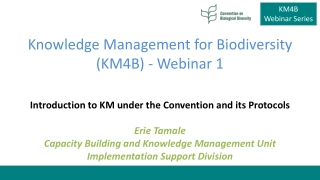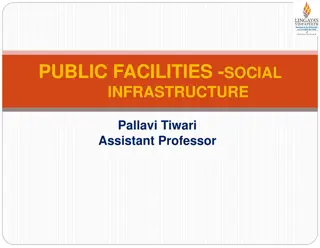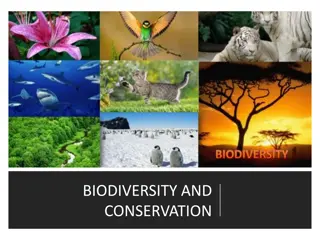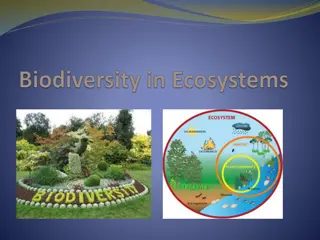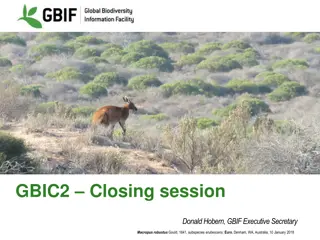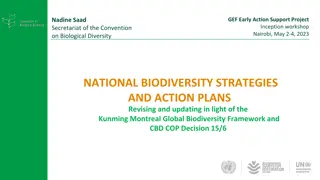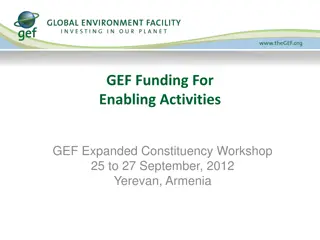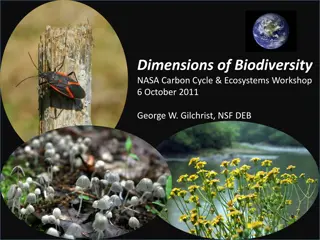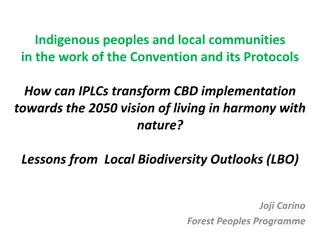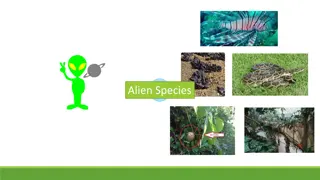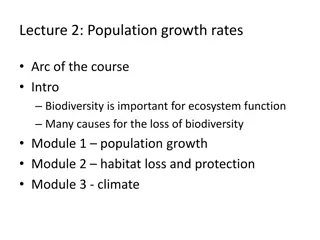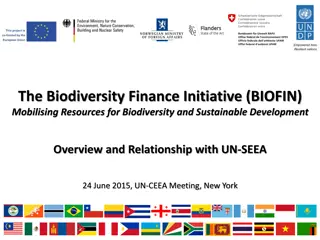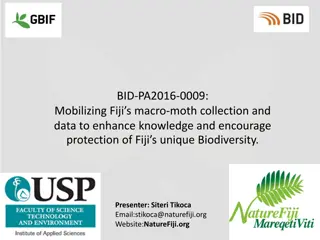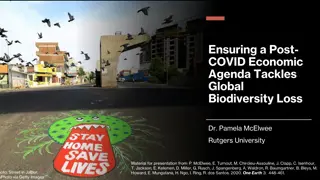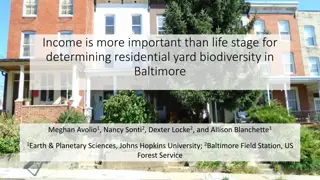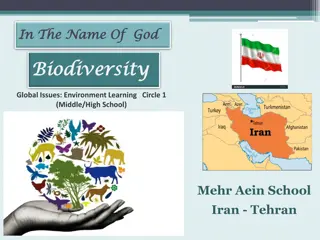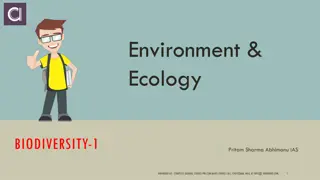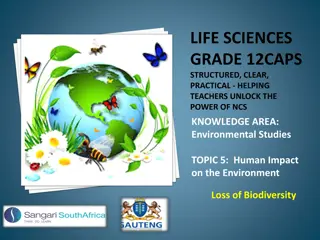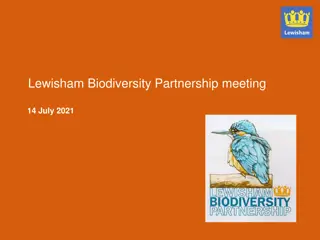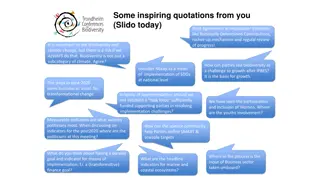Aichi Biodiversity Targets 2011-2020 Summary and Strategic Goals
The Aichi Biodiversity Targets outline strategic goals to address the underlying causes of biodiversity loss, reduce direct pressures on biodiversity, improve biodiversity status, enhance ecosystem services, and strengthen implementation. Targets include raising awareness, integrating biodiversity values into development strategies, sustainable resource management, habitat conservation, preventing extinction of threatened species, and enhancing ecosystem resilience. The plan emphasizes participatory planning, traditional knowledge respect, advancing biodiversity science, and increasing financial resources for implementation.
Uploaded on Oct 10, 2024 | 0 Views
Download Presentation

Please find below an Image/Link to download the presentation.
The content on the website is provided AS IS for your information and personal use only. It may not be sold, licensed, or shared on other websites without obtaining consent from the author. Download presentation by click this link. If you encounter any issues during the download, it is possible that the publisher has removed the file from their server.
E N D
Presentation Transcript
GEF 6 Programming Strategic Plan for Biodiversity, 2011-2020 GEF Expanded Constituency Workshop Windhoek, Namibia February 17-18, 2015
20 Aichi Biodiversity Targets Strategic goal A. Address the underlying causes of biodiversity loss Target 1: By 2020, People are aware of the values of biodiversity and the steps they can take to conserve and use it sustainably. Target 2: By 2020, biodiversity values are integrated into national and local development and poverty reduction strategies and planning processes and national accounts Target 3: By 2020, incentives, including subsidies, harmful to biodiversity are eliminated, phased out or reformed . Target 4: By 2020, Governments, business and stakeholders have plans for sustainable production and consumption and keep the impacts resource use within safe ecological limits. Strategic goal B. Reduce the direct pressures on biodiversity and promote sustainable use Target 5: By 2020, the rate of loss of all natural habitats, including forests, is at least halved and where feasible brought close to zero, and degradation and fragmentation is significantly reduced. Target 6: By 2020 all stocks managed and harvested sustainably, so that overfishing is avoided. Target 7: By 2020 areas under agriculture, aquaculture and forestry are managed sustainably, ensuring conservation of biodiversity. Target 8: By 2020, pollution, including from excess nutrients, has been brought to levels that are not detrimental to ecosystem function and biodiversity. Target 9: By 2020, invasive alien species and pathways are identified and prioritized, priority species are controlled or eradicated, and measures are in place to manage pathways to prevent their introduction and establishment. Target 10: By 2015, the multiple anthropogenic pressures on coral reefs, and other vulnerable ecosystems impacted by climate change or ocean acidification are minimized, so as to maintain their integrity and functioning. Strategic goal C: To improve the status of biodiversity by safeguarding ecosystems, species and genetic diversity Target 11: By 2020, at least 17 per cent of terrestrial and inland water, and 10 per cent of coastal and marine areas are conserved through systems of protected areas ... Target 12: By 2020 the extinction of known threatened species has been prevented and their conservation status, particularly of those most in decline, has been improved and sustained. Target 13: By 2020, the genetic diversity of cultivated plants and farmed and domesticated animals and of wild relatives is maintained, Strategic goal D: Enhance the benefits to all from biodiversity and ecosystem services Target 14: By 2020, ecosystems that provide essential services, including services are restored and safeguarded, Target 15: By 2020, ecosystem resilience and the contribution of biodiversity to carbon stocks has been enhanced, through conservation and restoration, including restoration of at least 15 per cent of degraded ecosystems, Target 16: By 2015, the Nagoya Protocol on Access and Benefits Sharing is in force and operational Strategic goal E. Enhance implementation through participatory planning, knowledge management and capacity building Target 17: By 2015 each Party has developed, adopted as a policy instrument, and has commenced implementing an effective, participatory and updated NBSAP. Target 18: By 2020, the traditional knowledge, innovations and practices of indigenous and local communities and their customary use, are respected. Target 19: By 2020, knowledge, the science base and technologies relating to biodiversity, its values, functioning, status and trends, and the consequences of its loss, are improved, widely shared and transferred, and applied. Target 20: By 2020, the mobilization of financial resources for effectively implementing the Strategic Plan for Biodiversity 2011-2020 from all sources,, should increase substantially .
Protection ABS Biodiversity mainstreaming Protected areas Understand values Sustainable fisheries Implement Nagoya Prot. Prevent extinctions Mainstream biodiversity Manage within limits Enabling Conserve gene pool Revise NBSAPs Address incentives Reduce pollution Respect and conserve TK Restoration Sustainable production Reduce invasive spp. Restore ecosystems Improve knowledge Halve rate of loss Minimize reef loss Mobilize resources Enhance resilience
GEF-6 Biodiversity Strategy Goal: To maintain globally significant biodiversity and the ecosystem goods and services that it provides to society BD 2: Reduce Threats to Globally Significant Biodiversity BD1: Improve Sustainability of Protected Area Systems BD4: Mainstream Biodiversity Conservation and Sustainable Use into Production Landscapes/ Seascapes and Sectors BD 3: Sustainably Use Biodiversity 6. Ridge to Reef+: Maintaining integrity and function of globally significant coral reefs 3. Preventing the extinction of known threatened species 1. Improving financial sustainability and effective management of the national ecological infrastructure 9. Managing the human-biodiversity interface 7. Securing Agriculture s Future: Sustainable use of plant and animal genetic resources. 4. Prevention, control, and management of invasive alien species. 10. Integration of biodiversity and ecosystem services into development and finance planning 2 . Nature s Last Stand: Expanding the reach of the global protected area estate. 8. Implementing the Nagoya Protocol on Access and Benefit Sharing. 5. Implementing the Cartagena Protocol of Biosafety
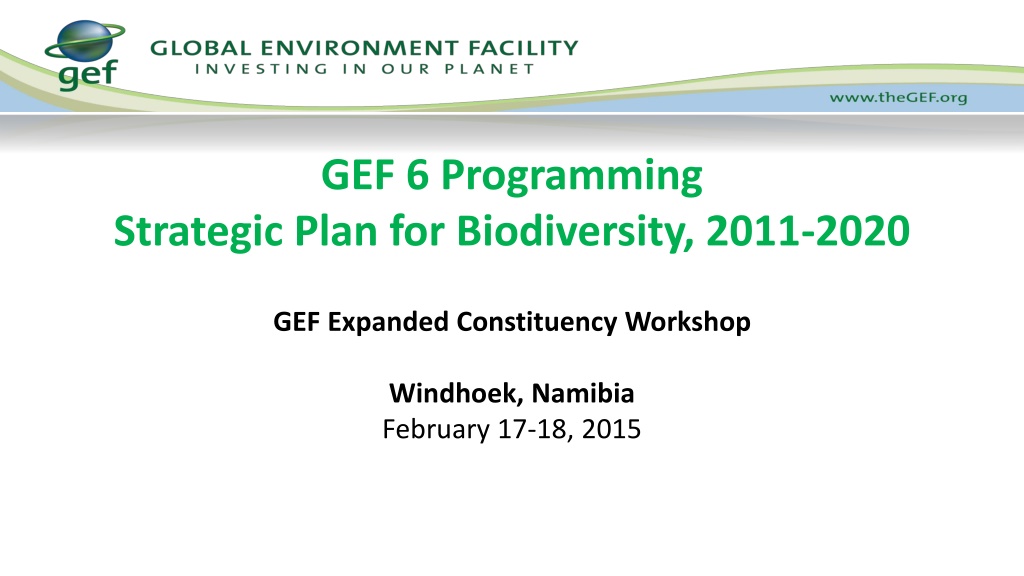
 undefined
undefined




